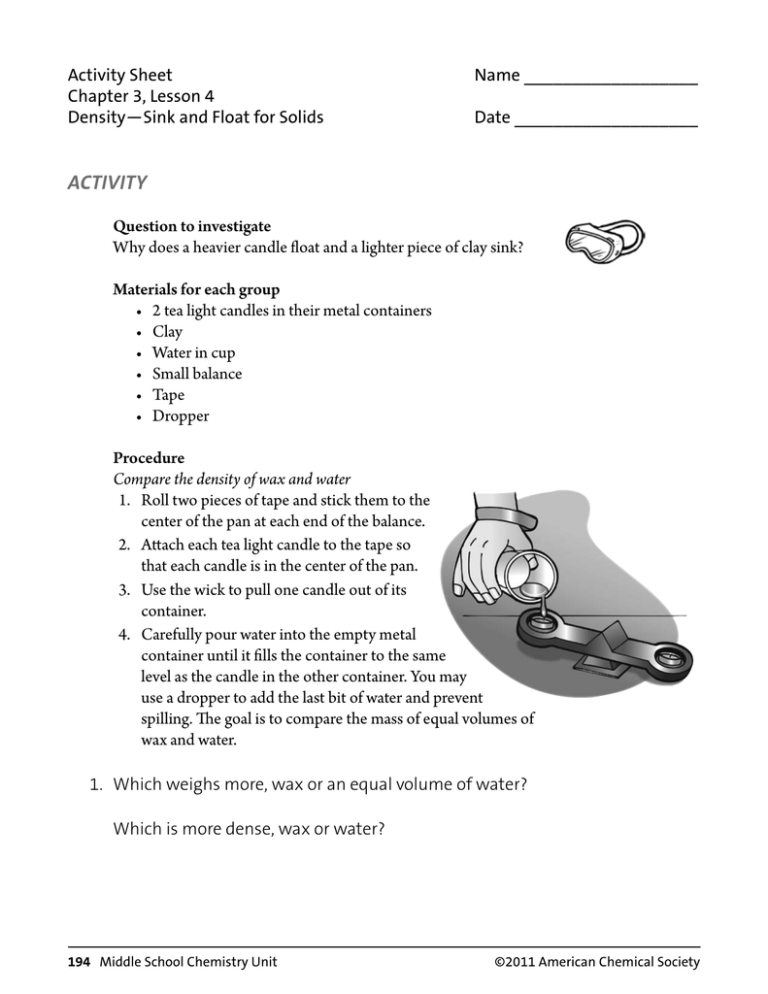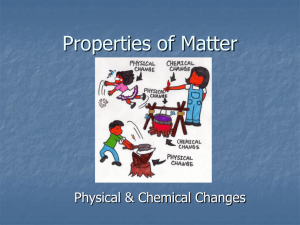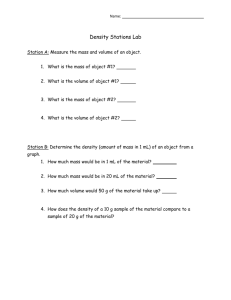Activity Sheet Name __________________ Chapter 3, Lesson 4
advertisement

Activity Sheet Chapter 3, Lesson 4 Density—Sink and Float for Solids Name __________________ Date ___________________ ACTIVITY Question to investigate Why does a heavier candle float and a lighter piece of clay sink? Materials for each group • 2 tea light candles in their metal containers • Clay • Water in cup • Small balance • Tape • Dropper Procedure Compare the density of wax and water 1. Roll two pieces of tape and stick them to the center of the pan at each end of the balance. 2. Attach each tea light candle to the tape so that each candle is in the center of the pan. 3. Use the wick to pull one candle out of its container. 4. Carefully pour water into the empty metal container until it fills the container to the same level as the candle in the other container. You may use a dropper to add the last bit of water and prevent spilling. The goal is to compare the mass of equal volumes of wax and water. 1. Which weighs more, wax or an equal volume of water? Which is more dense, wax or water? 194 Middle School Chemistry Unit ©2011 American Chemical Society Compare the density of clay and water 1. Make sure you have one piece of tape in the center of each pan on the balance. 2. Fill one container with clay and place it on the tape so that it is in the center of the pan. 3. Place an empty container on the tape at the opposite end of the balance. 4. Slowly and carefully add water to the empty container until it is full. 2. Which weighs more, clay or an equal volume of water? Which is more dense, clay or water? 3. Knowing the density of an object can help you predict if it will sink or float in water. If an object is more dense than water, would you expect it to sink or float? If an object is less dense than water, would you expect it to sink or float? ©2011 American Chemical Society Middle School Chemistry Unit 195 EXPLAIN IT WITH ATOMS & MOLECULES 4. Water is made up of small molecules of oxygen and hydrogen. Water molecules are closely packed together. Wax is made of carbon and hydrogen atoms connected together in long chains. Explain on the molecular level why wax is less dense than water. Clay is made of oxygen and heavier atoms such as silicon and aluminum. Explain on the molecular level why clay is more dense than water. 196 Middle School Chemistry Unit ©2011 American Chemical Society TAKE IT FURTHER 5. A giant log can float on a lake while a tiny grain of sand sinks to the bottom. Explain why a heavy object like the log floats while a very light grain of sand sinks. 6. Remember that the density of water is 1 g/cm3. Predict whether the following objects will sink or float. Will these objects sink or float? Object Density (g/cm3) Cork 0.2–0.3 Anchor 7.8 Wooden oar 0.4 Apple 0.9 Orange 0.84 Orange without peel 1.16 ©2011 American Chemical Society Sink or float Middle School Chemistry Unit 197 7. If a peach has a volume of 130 cm3 and sinks in water, what can you say about its mass? 8. If a banana has a mass of 150 grams and floats in water, what can you say about its volume? 198 Middle School Chemistry Unit ©2011 American Chemical Society






